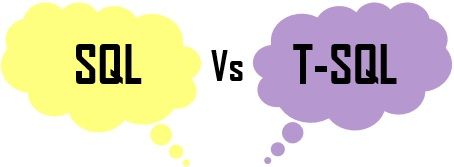 SQL and T-SQL are the query languages used to manipulate the database and are an important part of the DBMS. The prior difference between the SQL and T-SQL is that the SQL is non-procedural while T-SQL is a procedural language. T-SQL is an extension to SQL, developed by Sybase and Microsoft. It has additional features to the SQL like transaction control, row processing, exception and error handling and declared variables.
SQL and T-SQL are the query languages used to manipulate the database and are an important part of the DBMS. The prior difference between the SQL and T-SQL is that the SQL is non-procedural while T-SQL is a procedural language. T-SQL is an extension to SQL, developed by Sybase and Microsoft. It has additional features to the SQL like transaction control, row processing, exception and error handling and declared variables.
However, all these SQL server interactions are carried out by sending T-SQL statements to the server.
Content: SQL Vs T-SQL
Comparison Chart
| Basis for comparison | SQL | T-SQL |
|---|---|---|
| Basic | Non-procedural | Procedural |
| Feature | Open language | Proprietary |
| Functions provided | Data manipulation and controlling | Procedural programming functions and local variable |
| Query submission | One by one | Bulk transfer |
Definition of SQL
SQL (Structured Query Language) is a specifically designed language for defining, accessing and manipulating the data. It is non-procedural, where the essential elements and its outcome is first specified without describing how results are computed. The SQL implemented over the database which is driven by a database engine. The main task of the database engine is to interpret SQL statements and determine the accessing technique for retrieving various data structures in the database. This is an essential function of the data engine so as to evaluate the accuracy and efficiency of the results.
In the earlier days of the 1970s, a researcher working at IBM Dr E.F. Codd developed the relational data model and language named as DSL/Alpha by applying the accurate mathematic formulas to the data storage retrieval. Later, the IBM commissioned a project named as System/R, then the team developed a prototype of the DSL called SQUARE, renamed as SEQUEL and finally known by SQL.
There are two different groups of commands included in the SQL – DDL and DML. DDL expands to Data Definition Language used for defining and modifying several data structures. While DML (Data Manipulation Language) is intended to access and manipulate the data stored within the data structures previously defined by DDL.
Definition of T-SQL
T-SQL (Transact-SQL) is an extension of SQL. It is a procedural language, unlike SQL which is used by SQL server. It can be helpful in performing operations like retrieval of the data from a single row, insertion of new rows, retrieval of multiple rows. The syntax of the T-SQL is distinct from others like PL-SQL. However, it has the same functionality and generates similar results as other languages.
The T-SQL is Microsoft implementation of the structured query language for SQL server. The SQL server 2014 T-SQL was founded on the ANSI (American National Standards Institute) standards. Later Microsoft included numerous functionality enhancements in the T-SQL. It is also comprised of the DDL, DML and control-of-flow statements.
Key Differences Between SQL and T-SQL
- SQL is a non-procedural programming language devised for manipulating the data stored in the database. Conversely, T-SQL is a procedural extension of SQL.
- SQL is open standard while the T-SQL is proprietary.
- There are several DDL and DML commands and operations are provided in SQL but T-SQL provides some special features that are absent in SQL such as transaction control, error and exception handling.
- The query submission in SQL follows the pattern of processing a single query after the completion of the other. As against, in T-SQL, all commands are transferred to the server simultaneously.
Conclusion
SQL is the base programming language while the T-SQL is derived from SQL and enhanced form of the SQL.
James Booth says
Good article….
Pranaya says
Good one